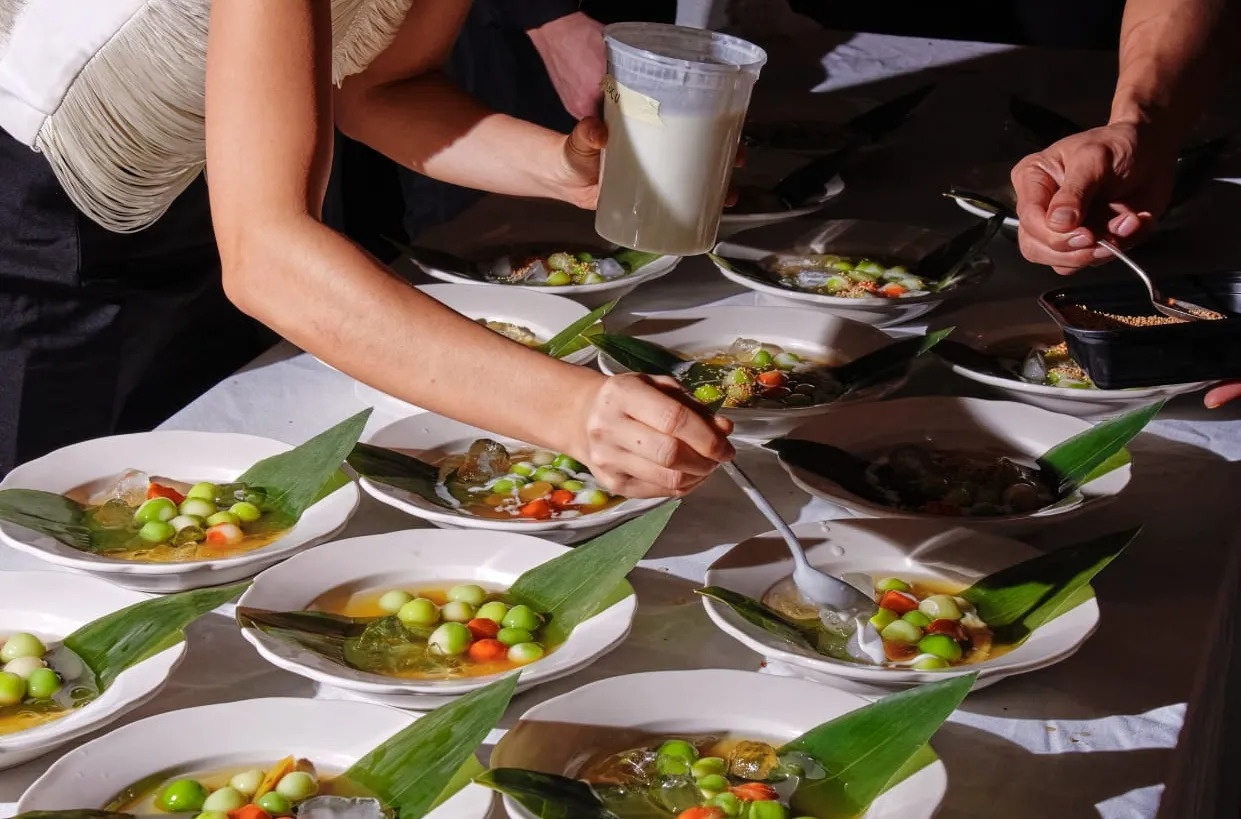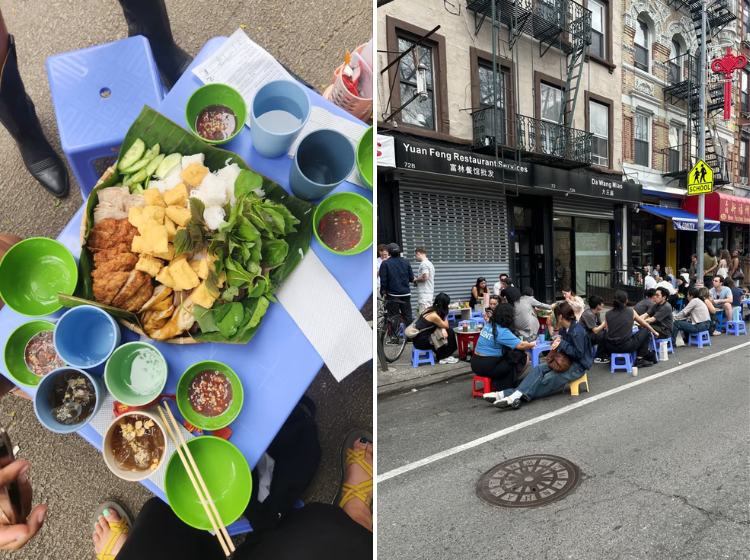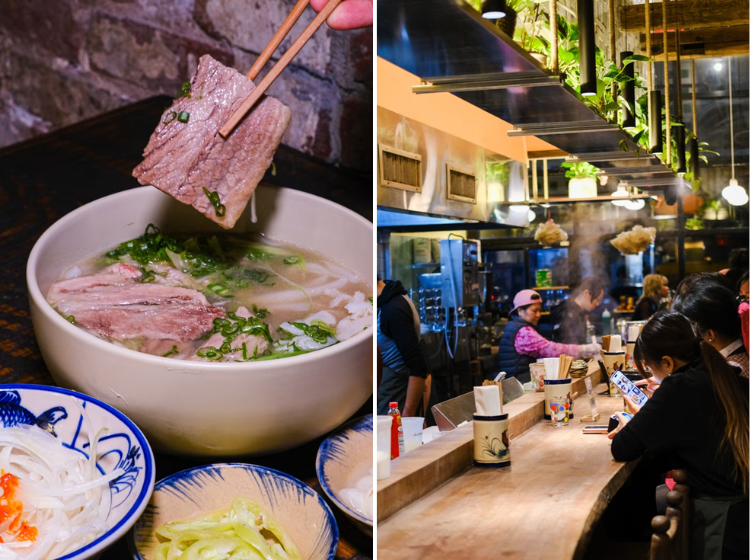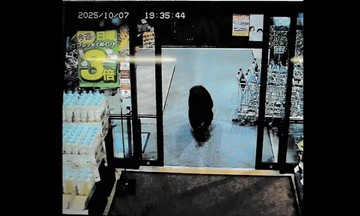The first Vietnamese restaurant in the US opened in 1961 in Manhattan's Morningside Heights. However, Vietnamese cuisine's presence in the bustling city remained limited compared to areas with larger Vietnamese communities, like California's Orange County or Houston, Texas.
From 2015 to 2020, New York saw its Vietnamese population grow by nearly 9%, exceeding the city's overall population growth and sparking a surge in Vietnamese culinary offerings.
According to the WSJ, a wave of small, casual eateries showcasing the "astounding richness" of Vietnamese food is flourishing in New York, captivating both residents and social media.
 |
Thu Pham Buser plates a Ha Giang thang den dish at a New York event. Photo: NY Eater |
Thu Pham Buser plates a Ha Giang thang den dish at a New York event. Photo: NY Eater
At MAM, located on the edge of Chinatown, chef Jerald Head and his wife, Nhung Dao, specialize in street food. Their bun dau mam tom (fermented shrimp paste noodles with tofu) is a standout, earning high praise from diners and New York food critics.
After a period of pop-up sales, the couple opened their permanent restaurant in 2023, importing low plastic stools from Vietnam and establishing a sidewalk dining area. "We're not just selling authentic Vietnamese food, but the whole experience," Head said.
In 2024, the couple opened a wine bar named Lai Rai on the same street. They plan to open a cafe and banh mi shop later this year.
In the nearby Lower East Side, Ha's Dac Biet, which opened in late 2024, offers dishes like sauteed snails with tamarind sauce, sauteed oysters with green chili, and "pate chaud" (savory pastries). The restaurant is so popular that reservations are nearly impossible.
Chefs Anthony Ha and Sadie Mae Burns, the husband-and-wife team behind Ha's Dac Biet, asked the New York Magazine food critic to temporarily hold off on reviewing their restaurant. They plan to open another restaurant, Bistrot Ha, nearby later this year.
 |
Bun dau mam tom and the outdoor dining space at MAM in New York. Photo: WSJ |
Bun dau mam tom and the outdoor dining space at MAM in New York. Photo: WSJ
A short walk away is Banh Anh Em, which opened earlier this year. Its menu is described as "very diverse, with subtle variations of classic dishes from all over Vietnam," such as Nam Dinh pho bo (beef noodle soup), Hanoi banh cuon (steamed rice rolls), and Hai Phong banh mi que (baguette sticks).
"When I first came to the US, Vietnamese cuisine seemed to revolve around pho and banh mi, with flavors quite different from back home. That's why I decided to open my own restaurant, with my own vision," said Nhu Ton, the restaurant's owner, who is originally from central Vietnam and moved to the US 13 years ago.
The restaurant does not take reservations, and the wait time can be up to two hours in the evening. Ton and his partner, John Nguyen, are planning a second location. Ton traveled throughout Vietnam by motorbike, sourcing ingredients and collecting recipes in preparation.
Observers note that the pop-up model is a pioneering approach used by Vietnamese entrepreneurs to spread their cuisine in New York. Both MAM and Ha's Dac Biet started as pop-ups.
Pop-ups are temporary food businesses, typically operating for a few days or weeks at a location, often utilizing flexible spaces like gardens, mobile stalls, or even high-end restaurants, and relying heavily on social media for promotion.
Notable Vietnamese pop-ups in the city include Be Bep by Phoebe Tran, specializing in postpartum vegetarian meals, and An Co by Thu Pham Buser, a mobile feast series showcasing the diverse cuisine of Vietnam's highlands.
 |
Nam Dinh pho bo and the dining space at Banh Anh Em, New York. Photo: WSJ |
Nam Dinh pho bo and the dining space at Banh Anh Em, New York. Photo: WSJ
In 2022, Trisha Do and her partner, Gui Trang, launched Xin Moi, a pop-up focused on Vietnamese home cooking because they "missed the hometown dishes they couldn't find in New York" and wanted to connect more deeply with their cultural roots.
They also operate pop-ups in Amsterdam, Paris, and Toronto, and frequently return to Ho Chi Minh City for inspiration. For Do, the recent boom in Vietnamese cuisine in Manhattan is understandable.
"Our grandparents and parents struggled with immigrant life. The next generation, freed from survival concerns, can now pursue creative endeavors alongside businesses in cities they love. This takes a generation," Do said.
Duc Trung (According to Financial Times, New York Eater, Washington Post)












